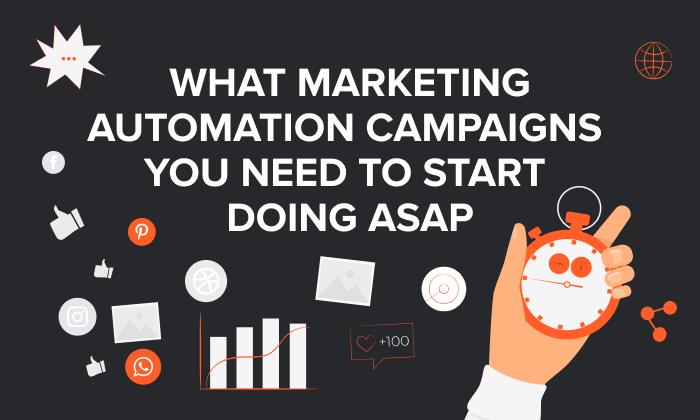
There are only so many hours in a day.
24, to be exact.
And if you’re like me, you have a list of seemingly never-ending tasks to fill those hours.
Social media posts, blog posts, SEO, PPC, financials, processes – you name it.
But when you’re scaling and growing your small business, you need to start cutting time from as many tedious tasks as possible.
You don’t have time to run the business and still email every single customer after they purchase your product.
You don’t have time to nurture prospects and leads with personalized messaging.
The thing is, it still needs to be done if you want your business to survive (and you do).
Thankfully, to continue nurturing your relationships with your customers and maintain your business, there’s marketing automation.
Instead of wasting time on menial processes, you can automate digital marketing tasks and save loads of hours and frustration.
And you won’t be alone.
In fact, more than 50% of companies are using marketing automation.
Almost half of B2B companies are planning to adopt it.
67% of the industry leaders in marketing are using automation to improve and grow their companies.
And they use marketing automation for a variety of objectives, from increasing ROI to getting more customers.
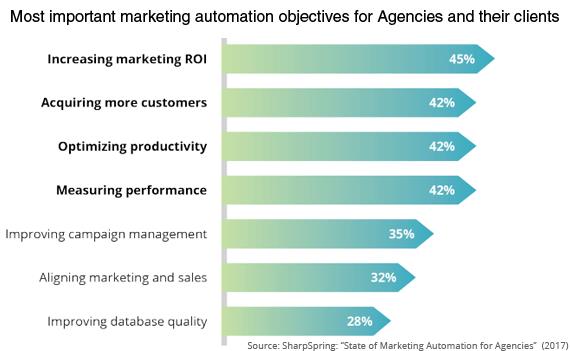
This means that the top marketers in the business are using this innovative technology to save time.
So, if you want to make your business more efficient, you need to be running these marketing-automation campaigns, too.
But, first, let’s jump into exactly what marketing automation is.
What Is Marketing Automation?
So, what exactly is marketing automation?
Here’s my definition:
Automating marketing processes that otherwise are tedious and take up too much time.
Yes, it’s simple, because it’s sort of a simple concept.
It’s pretty much exactly what it sounds like, but I know most people love specific definitions.
So, here is Google’s take on it:
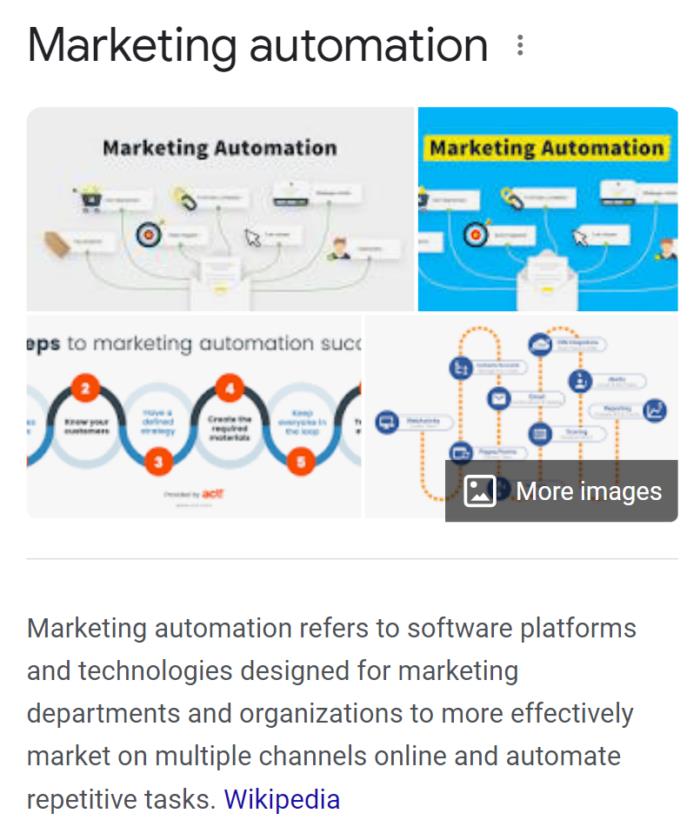
The last part is crucial here: automating repetitive tasks.
The goal of marketing automation is to cut down on time, improve efficiency, and run processes automatically that would otherwise suck your time and kill efficiency.
HubSpot defines marketing automation like this:
Marketing automation uses software to automate monotonous marketing work. Marketing departments can automate repetitive tasks such as email marketing, social media posting, and even ad campaigns.
They further describe it as taking repetitive tasks like email and social media and automating them to save time and money. It’s more than efficiency – it’s about a more personalized experience as a customer.
The point is to automate tedious digital marketing tasks that take you away from other things that need your attention.
And it’s safe to say that the adoption of marketing automation is growing fast.
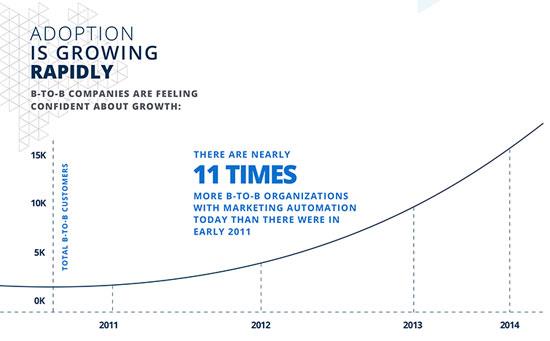
Heavy adoption of marketing automation started in 2014, and the growth since then has been trending upwards.
The majority of marketers believe that marketing automation is worth the cost and setup:
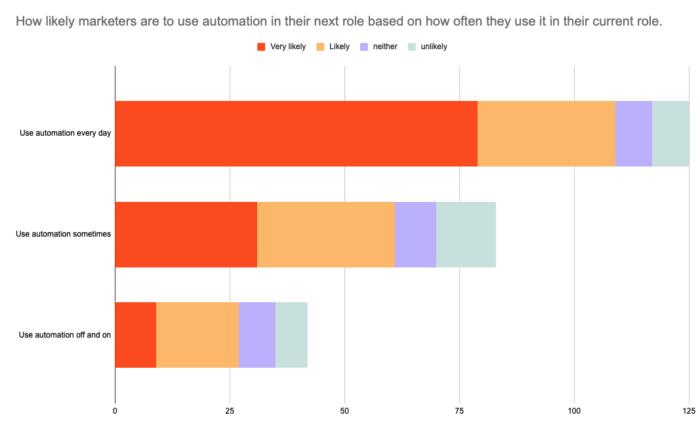
Meaning that most marketers are benefiting from the implementation and seeing positive ROIs.
On top of that, most marketers believe that they are successful at achieving important objectives through the use of marketing automation techniques.
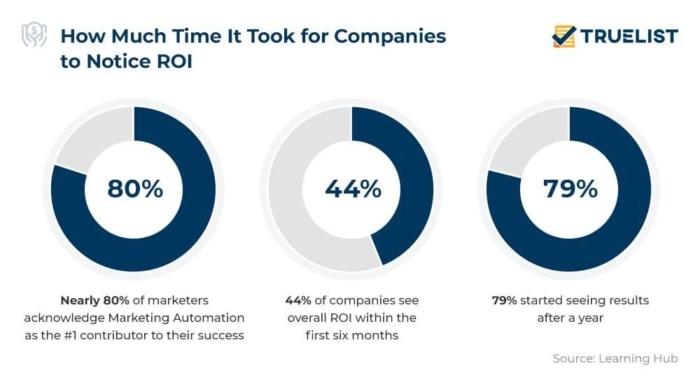
But, tons of marketers still don’t have integrated systems and aren’t taking advantage of marketing automation.
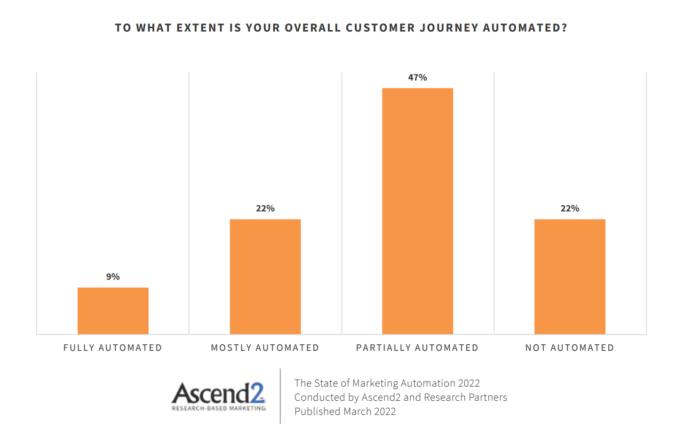
And they should be.
I use tons of marketing automation techniques every day.
From scheduling social posts to automated emails and nurturing tactics, the options are nearly limitless.
I can even set up automations based on traffic or new leads.
Marketing automation has saved me countless hours that I would have spent on email and social media.
And today, I’m going to share some of my favorite marketing automation campaigns that you need to implement ASAP.
Let’s get started.
Add Facebook Leads Into CRM or Email and Welcome Them to Your List
One of my favorite tools for collecting leads is using Meta(formerly Facebook) Lead Ads.
These lead ads are one of the best ways to collect leads and build your email list.
Why? Because they integrate so well into Facebook and are one of the least-boring lead forms I’ve ever used.
Here’s an example of what they look like. The first step in this multi-level form is:
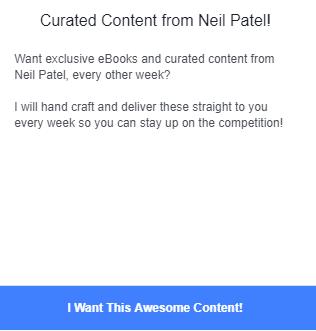
And once they hit your CTA, they have a basic information screen to fill out:
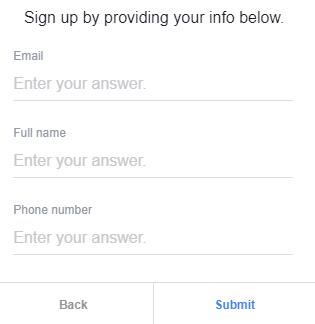
Here’s a better, full example of the entire process that Facebook users will see when they click on and fill out your lead-generation forms:
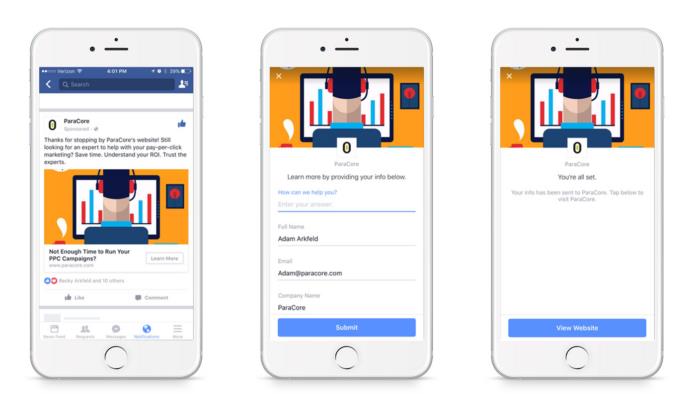
With that said, where do the leads go once someone fills out the form?
That’s one of my main concerns (and many marketers I’ve worked with) with Facebook Lead Ads.
It turns out that the leads simply go to Facebook’s own Forms Library on your Business Manager account:
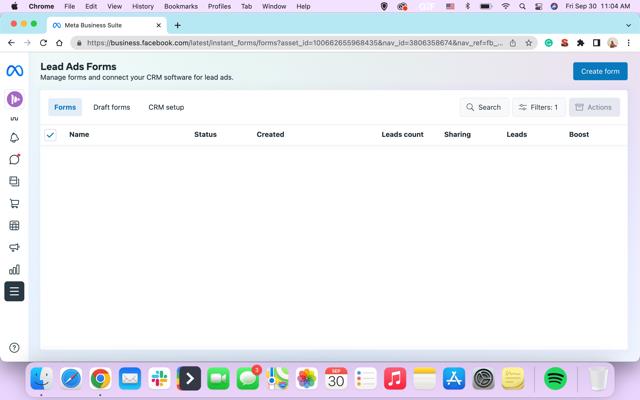
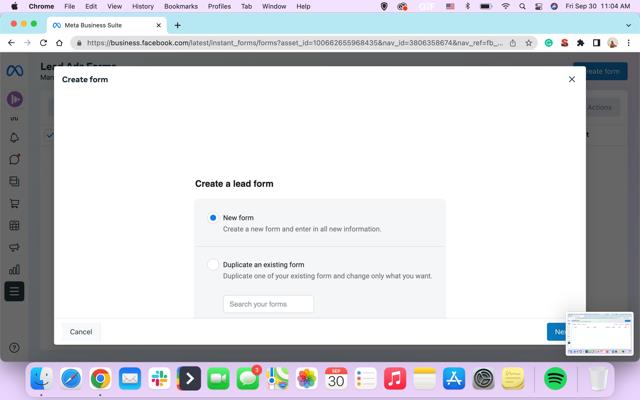
Personally, I don’t want to waste my time going to the forms library and sorting the data myself.
And isn’t the point of automation all about saving time?
After you check out the new leads, you have to tediously upload them to your CRM or email management software to start running campaigns.
Again, I don’t have time for that.
Then, you have to take your newly-uploaded email list and start setting up campaigns.
What if you could automatically do that, though?
What if you could just set up your Lead Ads and have someone a lead imported into your CRM or email platform once they submit the form?
Then they’ll be automatically placed into an email campaign.
Luckily, this is a possibility.
Simply fire up tools for marketing automation like Zapier to get started.

Zapier is probably my favorite tool to use for developing incredibly fast, easy integrations and automations.
It connects to hundreds (if not thousands) of applications that you likely are using.
For example, you can connect your calendar to Slack, your social media to a workflow, or even import your Lead Ads data into your favorite email program.
The options are nearly limitless, and the ease of use blows other products away.
For this automation campaign, we obviously want to import our Facebook Lead Ads data into a CRM or email platform to save time and automate digital marketing for the process of new campaigns.
To get started, select Facebook Lead Ads from the “Workflow Ideas” section:
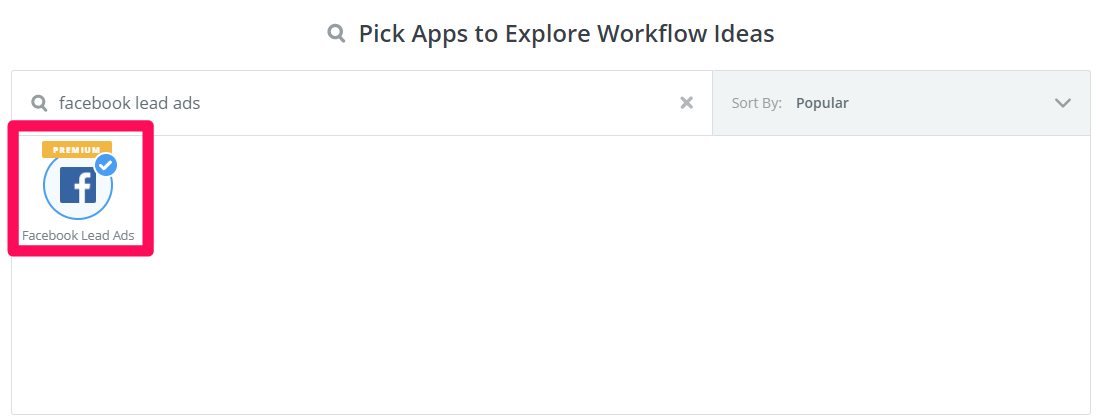
Next, click “Make A Zap!” to get started:

Now your selection of Facebook Lead Ads should show up as a “Trigger” on your new Zap:

A trigger is simple:
It basically means that when someone fills out your lead form, it will trigger the following actions that you set.
It’s the spark or catalyst to your automation campaign.
Whenever an action happens on your lead form, the reaction you set will occur.
Next, be sure to connect your Facebook account information to get started:
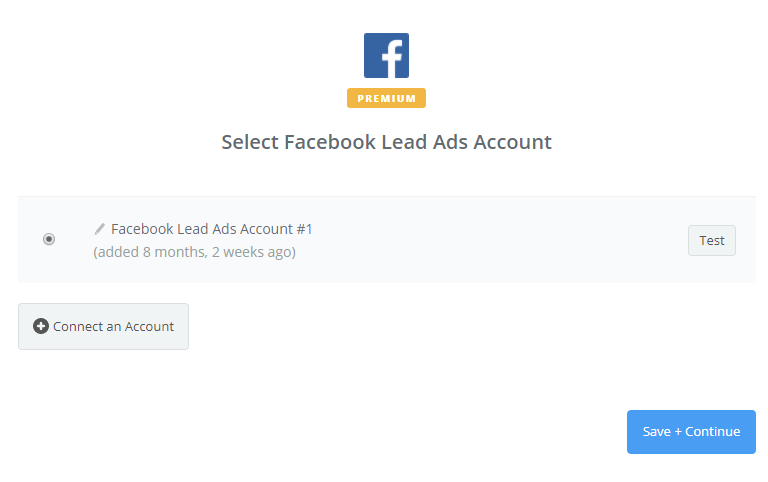
Then you’re going to want to select the specific Facebook Page that you will be using for advertising.
On top of that, you need to select the specific form that you want to use for this automation campaign:
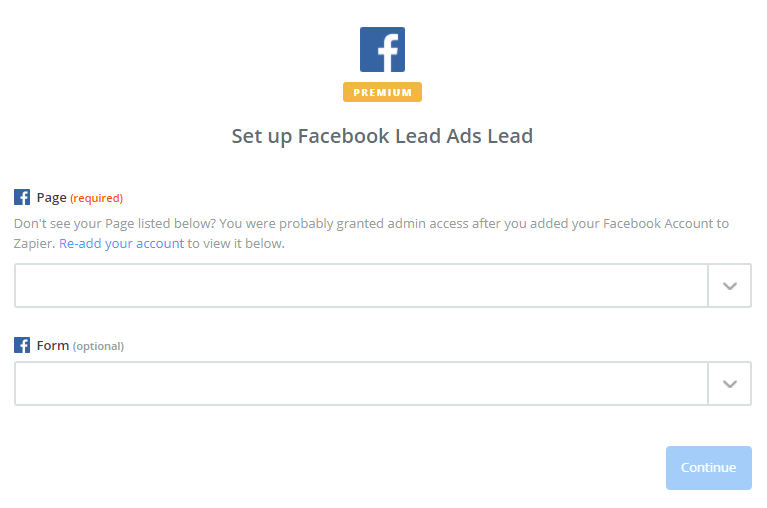
Next, you need to move on to the action step:
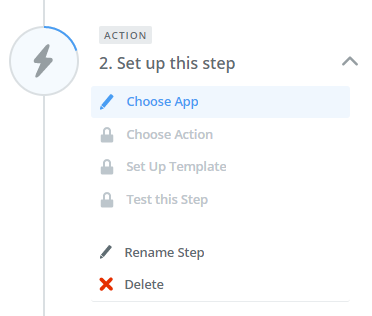
This is where you will determine what happens with the lead-form data from your Facebook Ads.
For example, you can select your favorite CRM like HubSpot or Salesforce.
Or, select an email-management software like MailChimp or ConstantContact.
Simply use the search bar to find the application you want to use:
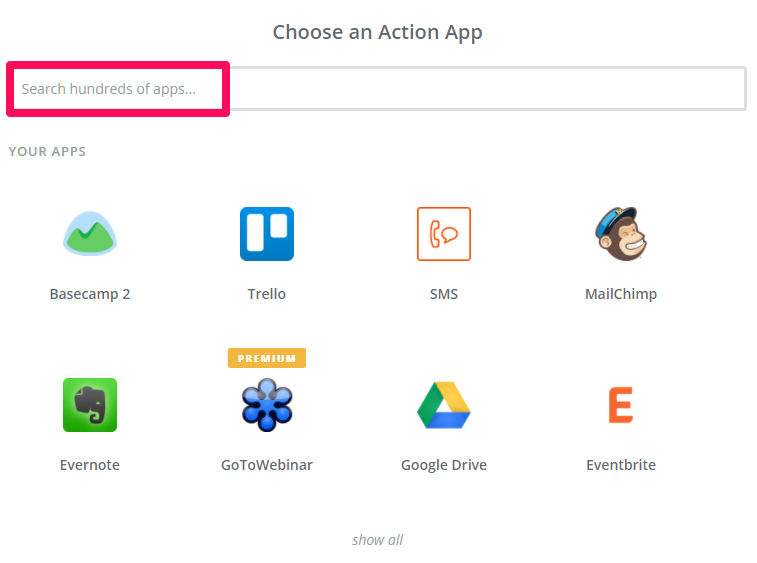
For this example, we can use MailChimp since it’s likely to be the most common platform for emailing and nurturing leads.

Next, you need to select the action that will be triggered by the Facebook Lead Forms:

For this example, we want to select “Add/Update Subscriber” because this will automatically populate leads from Facebook into a new list.
You’re pretty much done after this, but you can further customize some of your options.
For example, I recommend using the “Send Welcome Email” option for new leads:
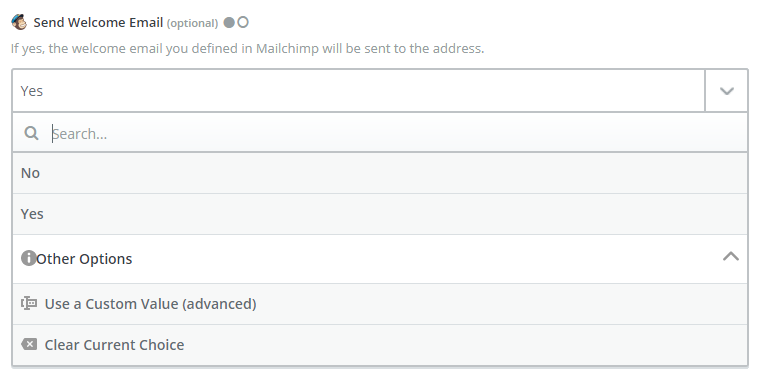
This will send your new leads an instant welcome email, automating the whole process even more.
Now instead of setting up Facebook Lead Ads, reviewing them in Facebook, downloading them, and uploading them into your platform to set up for a new campaign, you’ve automated it.
Your next step is to simply sit back and watch the leads come in and receive your emails without lifting a finger!
If you want to do this for your CRM (like Zoho, HubSpot, etc.), simply repeat the process but choose your own CRM instead of MailChimp as the “Action” step.
And if you want to use this for non-Facebook leads, you can set it up for tons of form applications on your website like Gravity Forms and more!
Pro tip: I also recommend putting these new leads into their own group. Make multiple automated processes on Zapier for each individual Facebook Lead Ad.

Automatically Share Curated Content on Social Media
Another one of my favorite unconventional marketing automation campaigns is to automate social media marketing for the process of sharing content.
Social media can quickly eat up your time throughout the week.
And most people spend way too much time on social media every single day:

And it’s not just your everyday social media user that can’t seem to put their favorite platforms down, either.
Marketers, on average, spend many hours every week on their social platforms of choice. If you want to know what’s getting done during these periods, they’re retargeting ads most of the time:

And if we’ve learned anything about social media from direct usage, it’s probably how utterly time-consuming and distracting it can be.
Be honest with me: how often do you get caught up on Twitter or Facebook and look at the clock to see that 25 or 30 minutes have gone by?
It happens to me more than I’d like to admit.
And that’s why I use this marketing automation tactic.
I used to spend way too much time on social media. It was taking me away from the business aspects that really needed my attention.
Now, instead of wasting my time on social, I’ve automated the process and can spend more time with clients, where real ROI is produced.
To do this for yourself, you’ll need to make a Feedly account.

Feedly is a great tool for curating content from your favorite industry blogs and thought leaders.
I use it every day to find the latest trending content!
I follow industry experts and get their content delivered via email daily:
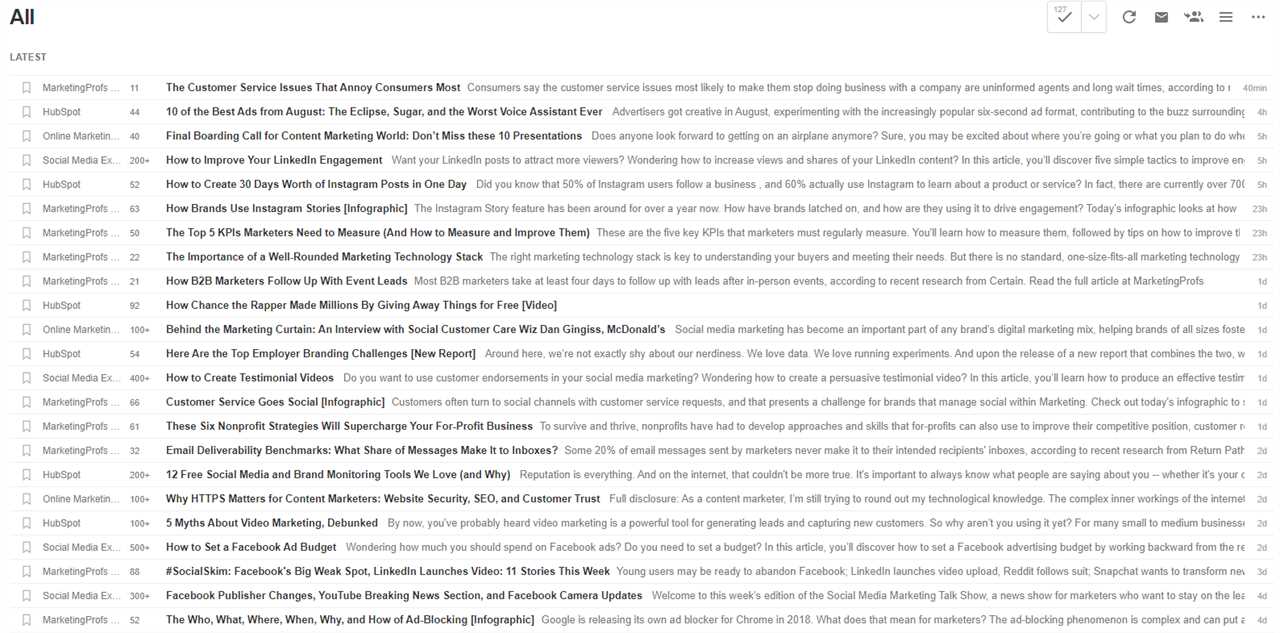
And, like Zapier from before, you can automatically send that curated content to your social platforms.
So, instead of wasting time reading through the curated content and crafting a tweet, you can automatically do it.
And curated content needs to be a part of your social strategy.
Simply posting every new blog post on your Facebook won’t develop your status as a topic expert.
Sharing other topically-relevant pieces from experts will.
To get started, open up Zapier and search for the Feedly integration:

Next, select the Buffer integration that will show up below the “Explore Workflow Ideas” section:

If you’re not familiar with Buffer, you should get familiar with it.
It’s a tool that will allow you to schedule tons of social media posts in advance for every social platform you have.
Can you imagine not having to go to each platform and share the post individually?
I can, and it’s amazing.
Instead, Buffer will share the same post to all of your channels at the times you provide.
Next, make sure Feedly is selected as your “Trigger:”
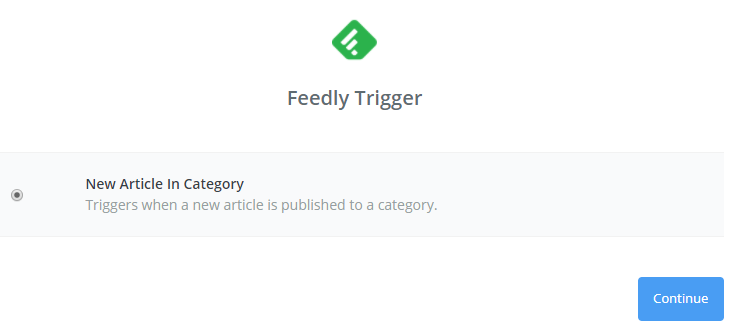
Now, simply connect your Feedly account to get started:
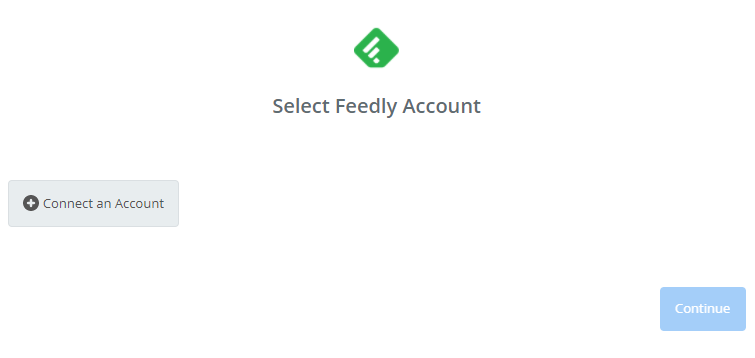
(Disclaimer: you need a Feedly Pro account to use this integration. Thankfully, it’s only $7 a month or $62 for an entire year)
And remember, sometimes you have to spend money to make money.
Look at the opportunity cost:
The average marketer spends five to six hours a week on social media.
That means you’re spending 260 hours a year on social media.
Multiply that by your current wage/salary, and that’s how much money you are spending on social media marketing (and that’s without even counting ad spend!).
Now, does $62 seem like a bargain? I bet it does.
Plus, it saves you from having to spend hundreds of hours.
Now that you’re convinced, let’s go back to the setup process.
Select the category from Feedly that you want to share content from.
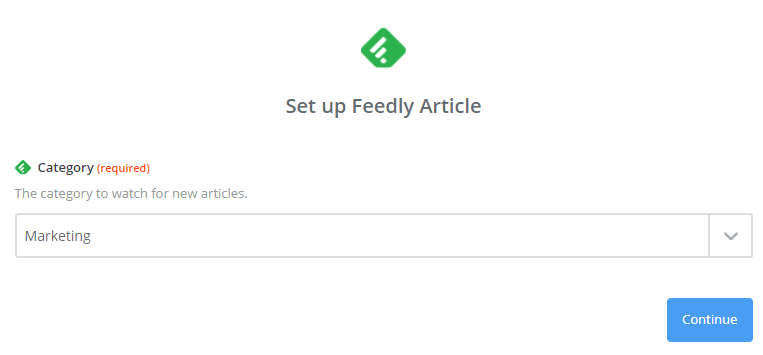
To set up categories on Feedly, simply search for an industry publication to follow, then click “Create A Collection.”

This will create a new “category” for you to pull posts from for this automation.
Next, simply select “Add to Buffer” as your action!
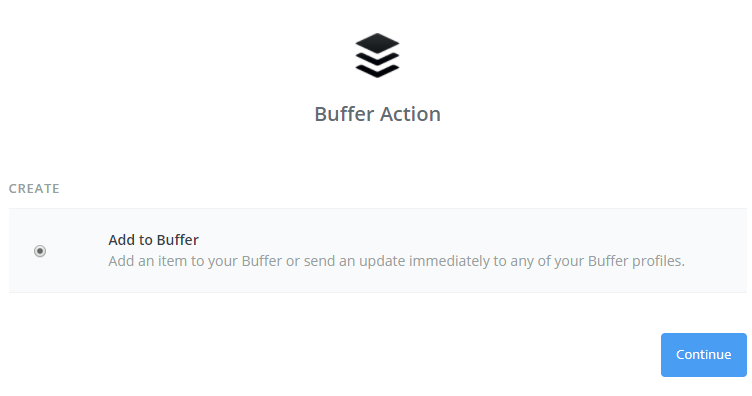
And that’s it.
Now you don’t have to curate a single thing on your own. Feedly will automatically pull in new content based on your selected categories and who you follow.
Then, it will send those articles into Buffer and add them to your queue.
Just kick back and let the posts share themselves.
Shopping Cart Abandonment Emails Automation
Shopping cart abandonment emails should be the bread and butter of your marketing automation.
Want to drive more sales and close those deals that were left open?
You need to use cart-abandonment emails!
Almost 70% of e-commerce carts will be abandoned with products left in them.
That’s nearly 70% of your sales that you risk losing out on without automating for e-commerce via emails.
Someone took the time to peruse your product and place it in their cart. There is definite interest there.
Don’t let the sale slip away.
With simple Shopify settings, you can easily send cart-abandonment emails.
To get started, log in to your Shopify account and head to the admin section.
Click on your settings tab.
Then, click on “Checkout:”
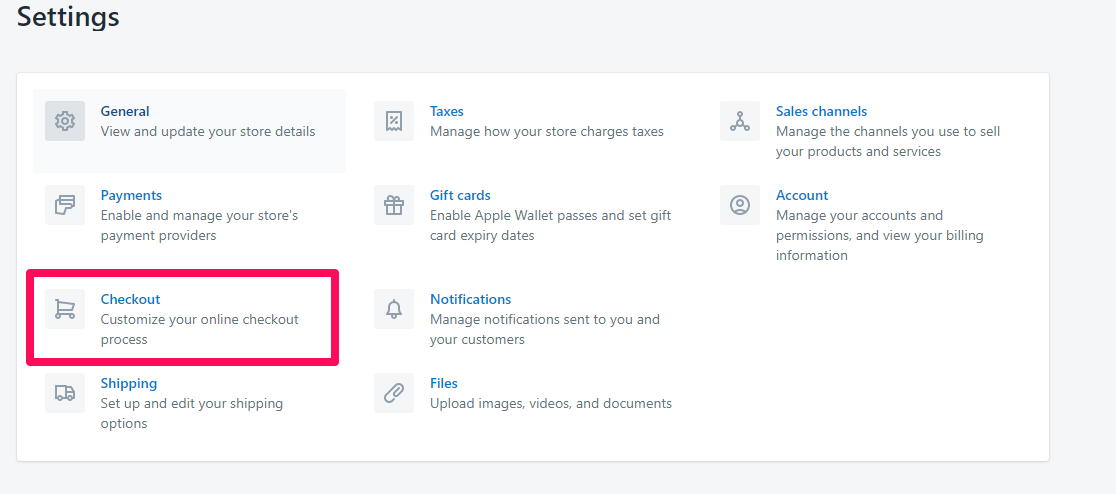
Scroll down to the “Order processing” section and make sure to select the following option:
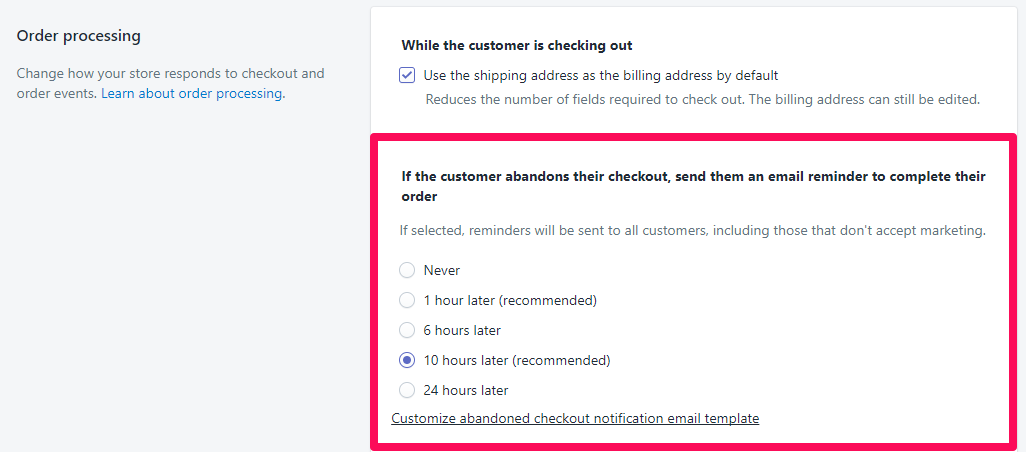
It’s that simple! Now you can automatically send these people emails that will directly take them back to their abandoned carts to hopefully get that conversion the second time around.
I love this one from Black Milk Clothing.
Who can resist a plea from a cute dog?
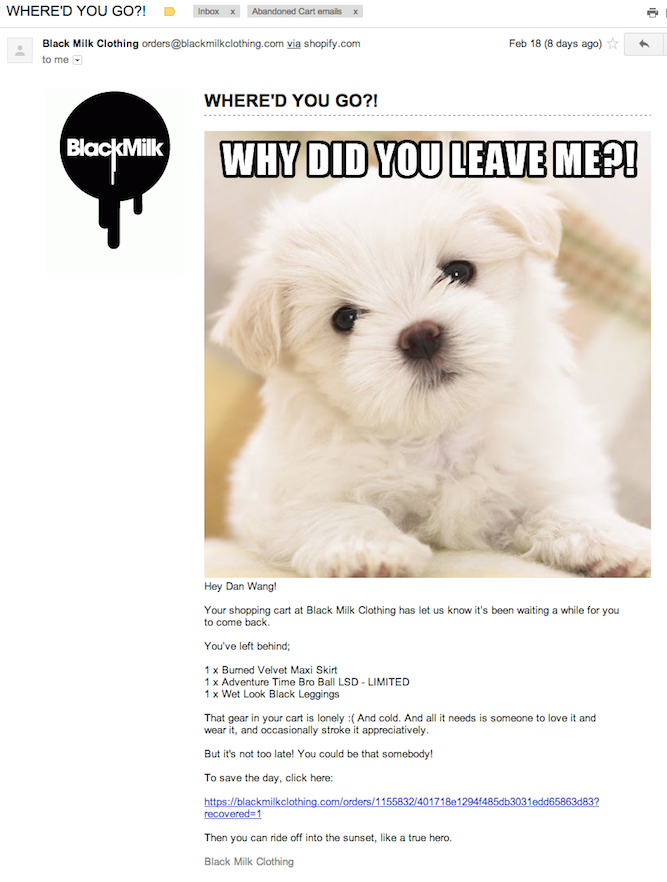
Frequently Asked Questions
How do I find the best automation tool?
When you’re looking for automation tools, be sure to take your time and do your due diligence. Try to get reviews and impressions both from sources in your own network as well as industry experts you trust. If there’s an opportunity to take advantage of a trial, feel free to do so. However, in order to have the most success here, you need a clear picture of how you plan to use automation and what your tools are. This will help you find the best fit to manage your needs.
In marketing, what should I automate first?
This question is ultimately dependent on what marketing channels your company uses and what goals they have. If your goal is to try and use automation to scale your operations, you may want to start with one of your largest marketing areas, like email. If your goal is more about freeing up time for a limited marketing staff to work on essential tasks, choosing a smaller area of your marketing, like social media, may make more sense.
The difference between marketing automation and campaign management?
Marketing automation is the use of technology to streamline processes that are tedious or take up time to reach desired results. This is different from campaign management that focuses on the process of designing, tracking, executing, and analyzing marketing campaigns.
Why should small business owners should automate digital marketing?
Not only can you reach more prospects effectively, you can automate tasks like email marketing, social media, and website updates to focus on other business tasks and new ideas.
Conclusion
As marketers, we’re constantly stretched for time.
We’ve got things to do, people to see, and customers to convert.
There’s not always enough time in the day to complete everything on your list.
Rather, there’s not enough time in the day to complete everything on your list without a little help.
And that’s where marketing automation comes into play.
You just don’t have time to nurture prospects on your own, like you did in the startup stages.
But, you still need personalization and well-timed messaging.
You need to have a guide to marketing automation as a launchpad if you want to scale efficiently.
Start by automating your lead flows. When a form is completed, send those new leads into your CRM or email platform to automatically start new campaigns.
Then, automate your social media marketing strategy. Stop wasting precious hours on social media and start automating your sharing process with tools like Feedly and Buffer.
And remember, always use shopping cart abandonment emails to have a second shot at converting customers.
Finally, make sure to block out a few minutes in your schedule to pat yourself on the back for saving so much time.
Feels good, doesn’t it?
What marketing automation campaigns have you found success with?
Frequently Asked Questions
Why is motivation important to an entrepreneur?
Motivation is the fuel that drives us forward when we feel stuck or lost. Motivation gives us the courage to face our fears, and makes decisions that may seem impossible or risky.
Motivation is key to success. Lack of motivation can cause us to become lazy, unmotivated or unproductive, ultimately leading to our failure.
To unlock your potential, you must find ways to motivate. This means finding a way to stay motivated throughout the day.
It is like a muscle. The more you work it, the stronger it will become. If you don't exercise it, it begins to atrophy and weaken.
Entrepreneurs who are self-motivated are some of the most successful. They set goals and plan the steps to reach them.
But there are times when you may need help staying motivated. Here are three simple steps to help you keep going.
Step 1) Get inspired. Find an inspiration figure. Someone who is already achieving your goals.
Step 2) Set small goals. Make sure that each goal is reachable. Focus on the next step rather than the ultimate result. By breaking big goals down into smaller ones, you'll be able to reach them faster.
Step 3. Reward yourself. Reward yourself for achieving your goals. You don't need to get something in return; you could just be enjoying the time spent doing something.
Motivation is a choice. Choose happiness, choose success and choose to live abundantly.
Start today if you are ready to make a change in your life. The first step to making a change is to choose to do so. Then take action. Now is the time to live your dreams.
What makes a successful entrepreneur?
There are two types, those who make their money and those whose time is theirs.
Their approach to their business is the difference. Money-makers focus on making more while time-makers focus on making more.
The desire to have financial freedom is what drives those who make money. Their goal is becoming and staying rich.
They are motivated by fear, greed, and a sense of entitlement. They are motivated by fear and greed, but they don't think about the long-term.
These people are often called hustlers. They are focused on the bottom line and seek ways to increase revenue, without regard for quality.
Some people make their own time. These entrepreneurs are driven by passion. They want to create something meaningful that will last forever.
They are motivated by altruism. They are motivated to do great work. They are passionate about creating services and products that make a difference.
These people are often called dreamers. They are driven by inspiration and vision. They know that success requires hard work, perseverance and dedication.
They are creative, which is the most important attribute of these entrepreneurs. They are constantly seeking out opportunities that haven't been done before.
They thrive in the unknown. They will spend hours researching any topic that interests them. Because they love learning new things, they are always open to trying new ideas.
It is also why they are adaptable to changing situations. They don't mind getting dirty or doing whatever it takes to win. The only thing they won't tolerate is mediocrity.
What type of entrepreneur would you be? Are you driven to make it big or do you want to find meaning in life?
Congratulations to those who answered yes to both of these questions! You are a successful entrepreneur.
I've met many successful entrepreneurs over the years and noticed one common trait among them: they were driven by passion.
The only thing that defines successful entrepreneurs is their financial wealth. Their impact is what defines them.
Steve Jobs, who was not rich but well-known for his philanthropic efforts, is an example. He did not own a home until his 40s.
His ability to create products that have changed the world was what gave him his wealth. This is what defines him.
Your job is not to make wealth. It's not to amass power or build empires.
Your job involves building relationships with customers. To build trust. To inspire others to succeed.
To have a positive impact. It is your legacy. That's your legacy.
We'd love to talk with you if we can help you build a lasting legacy.
Here at Social Media University, we'll show you how to earn passive income online. We'll show how to market your business so it grows naturally.
What keeps you motivated as an entrepreneur?
My greatest motivator is freedom. We live in a world that limits how much we can earn, save money, invest and buy, as well as our ability to borrow, rent, drive or fly. We are not subject to these limitations. We can pursue our dreams, and make them real.
We cannot allow ourselves to be enslaved with these limitations. If we do that, we lose sight the fact that our destiny is ours. We are the captains and crew of our ships. We are the architects in our lives.
I am driven by the desire to create wealth beyond my wildest imagination. To create businesses that surpass the limits of human potential. To create businesses that can change the way people live their lives forever.
To build more powerful businesses than any government and to be more influential than any religion.
It's why I'm here. I am determined to help entrepreneurs grow businesses faster than anyone else. Because when you succeed everyone wins.
What are the five most important motivators for entrepreneurs?
Motivation is key to success. Without it, there would be no success. We wouldn't exist without it.
Motivational psychology examines how motivation affects human behavior. We do amazing things when we are motivated. But it's also clear that there are limits to our motivation.
The five most important motivational factors are:
- Autonomy - The freedom to choose
- Mastery is the ability or capability to master certain skills
- Purpose – The sense of purpose
- A feeling of belonging through the concept of relatedness
- Reciprocity, the desire to give and receive
These motivators may seem like they could be used to motivate your business. However, each one offers a slightly different perspective of why people act the way they do.
An individual may seek autonomy to be able to choose his own path. Or he might want to mastery because he wants more skill at his job.
So on. These are just some of the motivations that could be used. There are many more. However, which ones might be most applicable to your particular situation. It all depends on you.
In order to find out, I'd recommend writing down three words that describe your ideal work environment. Then take those same words and apply them to your current working conditions.
If you find it difficult to think of ideas, try asking yourself this question: "Why are I doing this?" If you can't think of any ideas, ask yourself: "Why am I doing this?" This will help identify your goals.
Once you've identified your goals, it is possible to begin to assess where you are at the moment. You can use that information to determine if it is time for you to make changes.
If you don’t wish to change anything, then it’s time to consider your options.
However, if you are looking to make positive changes in your life, you will need to begin thinking about how to motivate yourself.
Which of these motivators is most effective? It's hard for us to say. So instead of focusing on one single factor, focus on all five.
This will help achieve your ultimate goal of being an entrepreneur.
What are the different motivations for entrepreneurs?
Entrepreneurs can choose from three types of motivation. Each type has its own set of strengths and weaknesses.
External motivation is the most prevalent form of motivation. An individual wants more money. This motivation is usually triggered by financial concerns.
External motivation is driven mostly by personal interest, ambition and desire. This type of motivation leads to people who are extremely goal-oriented.
Inner motivation is much more rare. People who have internal motivation don't seek wealth. Instead they pursue other goals such self-development, fulfillment, and service.
People with internal motivation are frequently called "passionate" since they find satisfaction from their work.
Finally, intrinsic motivation is the least popular type of motivation. Individuals who find enjoyment and satisfaction in working towards a specific goal are called intrinsic motivation.
The intrinsic motivation of a person is more powerful than the external or internal motivation.
Motivation comes from within. It's based on the belief in certain talents and abilities. They have the ability to do things no one else can.
Realizing our talents and capabilities makes us happy and fulfilled. We feel important.
In essence, intrinsic motivation is what makes you happy. The joy that comes from knowing we can accomplish whatever we set our minds on is intrinsic motivation.
This feeling of accomplishment is what keeps us going through tough times.
In fact, if you don't enjoy what you're doing, then why bother doing it at all?
Click here for more information about motivational entrepreneurship.
How can entrepreneurs motivate employees?
Motivation can come from any source. It doesn't matter from where motivation comes, as long as it inspires people to take action. Motivation is essential for any business, no matter how it comes in the form of a carrot or stick approach.
Employees who feel motivated are more likely to do well. If you want a team that performs better, give them the tools to feel empowered and engaged.
You must create an environment that makes them feel valued. A place where they can grow and learn. Where they can contribute ideas without fear of punishment.
Employees thrive in a company culture that supports them. That's how you keep your best talent happy, loyal and productive.
To maintain a positive culture, you must reward the people who make it happen. This includes giving bonuses to those who achieve goals, providing training opportunities, increasing your pay rises, and offering perks such as insurance.
You also need to provide clear direction and communication. Ensure everyone knows what's expected of them and why.
Make sure that your policies and procedures have been written down. It is important that you designate someone to ensure that your policies and procedures are being followed.
And most importantly, communicate frequently. Make sure your team is informed about the latest happenings in the company. Let them know about the latest developments and plans.
Communication is essential, and taking care of your team will ensure that you remain ahead of the rest. They will take good care of you.
Without a great relationship with your employees, you could lose a lot of money. Studies have shown that high employee engagement results in higher productivity and profitability for companies than those that struggle to retain top performers.
It is important to realize that not all employees want to work at the same speed. Some people prefer to work alone, while others enjoy working in teams. You can motivate anyone in many different ways.
Some may be more inclined to accept recognition than others. Whatever works for you, ensure it aligns with the company's goals.
The leader is ultimately responsible for setting the tone. Open-mindedness is key. Listen to your team. You have to listen to your team if you want it done right.
Statistics
- “Life is 10% what happens to you and 90% how you react to it.” (oberlo.com)
- That means for $150,000, you could have bought 10 percent of Airbnb." (entrepreneur.com)
- I shifted my motivational point from something huge (and undefined) to improve by just 1% each day. (carolroth.com)
- “If you look to lead, invest at least 40% of your time managing yourself – your ethics, character, principles, purpose, motivation, and conduct. (americanexpress.com)
- "If you improve by just 1% every single day, in several months, you will have improved by 100%. (carolroth.com)
External Links
businessinsider.com
- 101 Best Inspirational Quotes For Entrepreneurs
- SpaceX employees face almost impossible goals from Elon Musk
due.com
oberlo.com
twitter.com
How To
What are three things that keep entrepreneurs motivated and successful?
Entrepreneurs must have motivation. Without motivation, it is difficult to be driven and determined to succeed. But what motivates you?
We stay motivated for three reasons:
- We love our business
- Our vision/mission is larger than ourselves
- We love to help others.
You can stay motivated by finding ways to tap into those motivations. For example, when we love our business, we feel great pride and satisfaction when we do well. When we have a big vision, we feel more satisfied knowing that we are making a difference in the world. We feel fulfilled when we feel a strong desire for helping others.
According to a University of Chicago Professor Emeritus Dr. John Cacioppo's research, the best way of motivating yourself is to concentrate on what you are passionate about. In his book "Loneliness", Dr. John Cacioppo stated that "the best source to motivate yourself is to care about something." It's a way to be more engaged and energetic. It makes sense that we will feel more passionate when we care about something.






